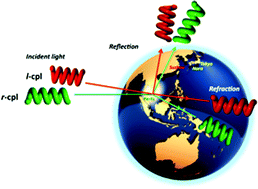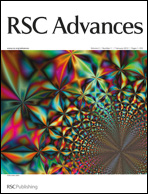Here we report the first chiral optofluidic system that enables the emergence and enhancement of chiroptical signals of μm-sized polymer particles from achiral all-trans-poly(9,9-di-n-octylfluorene-2,7-vinylene) (PFV) during mirror-symmetry-breaking aggregation due to the optically active fluidic media consisting of (R)-limonene (1R) and (S)-limonene (1S), chloroform and methanol. These results were proven by refractive index (RI) and specific rotation (SR) of the media as well as circular dichroism (CD), optical rotatory dispersion (ORD), circular polarised luminescence (CPL), UV-vis and photoluminescence spectral characteristics of PFV. For comparison, a triple bond linker poly[(9,9-di-n-octylfluoren-2,7-diyl)-alt-yleneethynylene] (PFE) aggregate, which is an analogue of PFV, did not show any CD-signals in the π–π* transition. Gaussian 03 (TD-DFT, B3LYP, 3-21G basis set) calculations of PFV and PFE trimer models suggested that PFV is CD-/CPL-silent helix due to an equal proportion of P- and M-helices in a double-well with a small barrier height, conversely, that PFE is inherently optically inactive due to non-helix conformation in a single-well. Under optimised chiral optofluid with specific RI values of 1.38–1.39, the μm-sized PFV particles showed a great enhancement in Kuhn's dissymmetry amplitudes by ∼1500 times compared to the computed value in helical models of PFV; the gCD at 473 nm reached +0.078 (1S) and −0.104 (1R), and the gCPL at 474 nm attained +0.056 (1S) and −0.077 (1R), while maintaining a high quantum yield (ΦPL) of 75–88% with a short PL lifetime of ∼0.5 ns. For comparison, as for six π-conjugated molecular aggregates with/without H–H repulsions, including trans-stilbene and diphenylacetyelene, with the help of the 1R-/1S-based media, any detectable CD signals were not observed. These results led to the idea that optically active π-conjugated polymers carrying longer alkyl side groups in a double-well potential may be needed to efficiently generate the corresponding optically active aggregates in the chiral tersolvents.


 Please wait while we load your content...
Please wait while we load your content...